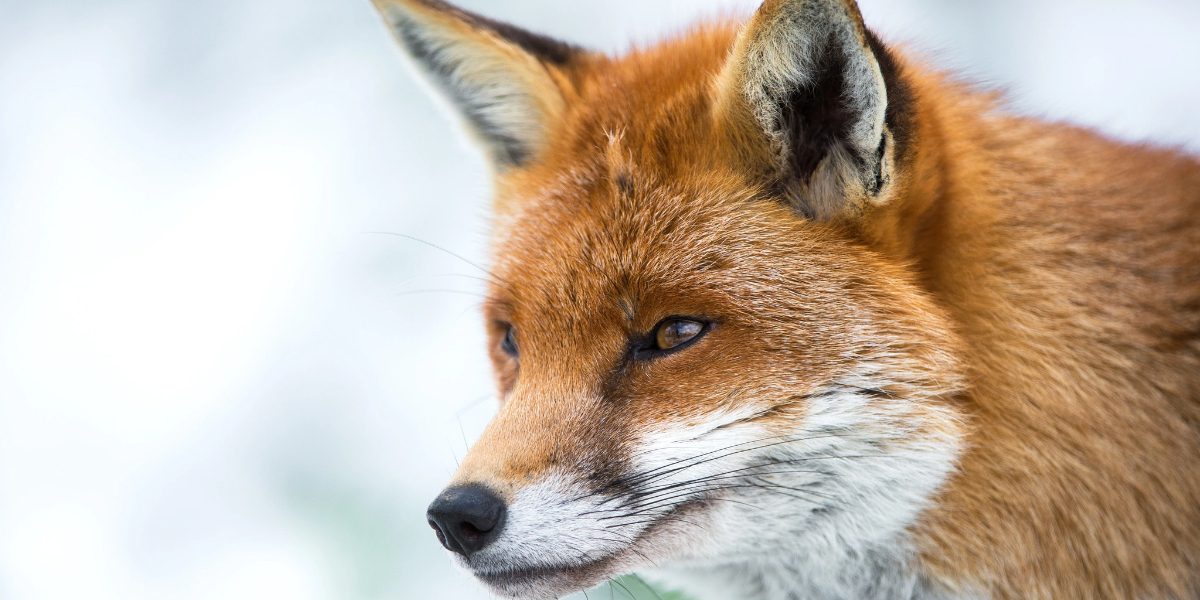Environmental influences play a big role in how foxes find their mates and raise families. When food is scarce, foxes tend to stick to monogamous partnerships, ensuring both parents care for their young. But in areas with plenty of resources, things get a bit wild—more males compete for attention, and you might see some foxes dating multiple partners to spice things up! Seasonal changes, like temperature shifts, affect breeding months too, leading to unique courtship behaviors. Curious about the details of these furry love stories? There's so much more to discover about how environment shapes fox romance!
Contents
- 1 Role of Environmental Conditions
- 2 Mating Systems and Monogamy
- 3 Courtship Dynamics and Behavior
- 4 Influence of Resource Availability
- 5 Effects of Seasonal Changes
- 6 Territoriality During Mating
- 7 Genetic Diversity in Breeding
- 8 Impact of Population Density
- 9 Conservation Implications
- 10 Frequently Asked Questions
- 11 Final Thoughts
Role of Environmental Conditions
Environmental conditions play an essential role in shaping fox mating behavior. You might be surprised to learn that food availability and rainfall patterns can greatly influence how foxes choose their mates.
In resource-scarce environments, monogamous pairings become more common, while during times of plenty, you'll find some foxes engaging in polygyny, which is a fancy way of saying one male mates with multiple females. For instance, during periods of abundant food, such as when small mammals are plentiful, foxes may experience shifts in their mating strategies, allowing for greater genetic diversity within populations, as highlighted in the notable fox species.
Resource distribution impacts these reproductive strategies too. When food is abundant, dominant female foxes may venture outside their primary social group to mate, enhancing genetic diversity. This is like ensuring a healthy mix in a family recipe!
Seasonal fluctuations, especially temperature changes, also dictate when these foxes decide to mate, with January and February being peak breeding months.
However, environmental stressors like habitat degradation can alter traditional dynamics, leading to increased male competition for mates. All these factors intertwine, demonstrating how foxes adapt their mating behaviors to their surroundings.
It's fascinating to see how these clever creatures navigate their world, ensuring their survival and the continuation of their species!
Mating Systems and Monogamy
When you think about red foxes, you might picture these clever creatures forming strong, monogamous bonds.
However, it turns out that while they seem devoted to one partner, there's a twist—many actually mix things up and have multiple mates, especially in urban areas.
Monogamous Pair Bonding
In the world of red foxes, monogamous pair bonding plays a crucial role in their breeding behavior. During the winter months, male and female foxes come together, forming strong bonds before mating from January to March.
These bonds are integral for raising their young, especially in environments where survival can be challenging, as both parents contribute to nurturing their offspring. While they might seem monogamous at first, research shows this isn't always the case.
Here are a few key points about their mating habits:
- Breeding season dynamics: Male foxes might only mate once with their vixen, but they often compete with other males for a female's attention during the breeding season.
- Resource availability: In areas where food is hard to find, monogamous tendencies are stronger, as both parents are needed to raise the young. Conversely, when resources are plentiful, you might see more polygyny — that's when one male mates with multiple females.
- Genetic studies: Surprisingly, about one-third of fox litters in urban areas have mixed paternity. This means that those charming male foxes sometimes have a few surprises in their family trees!
fox species exhibit fascinating adaptations
Genetic Diversity Implications
Monogamous pair bonding in red foxes doesn't always guarantee genetic uniformity within populations. While you might think these furry couples stick to each other, about half the time, they venture into more complex mating systems.
You see, resource availability plays a big role here. In urban environments, red foxes have shown impressive adaptability, allowing them to explore polyandry or polygyny during times of plenty, which enables multiple fathers for a litter—talk about a family affair!
Interestingly, about a third of fox litters have multiple fathers, challenging your assumptions about strict monogamous pairings. Dominant females often seek out extra mates to boost genetic diversity, leaving subordinate males with fewer opportunities to pass on their genes. It's a tough world out there!
When resources are scarce, monogamous breeding becomes more common, as these foxes focus on nurturing their young. In contrast, during times of abundance, they may embrace the idea of sharing parental duties—after all, teamwork can enhance survival rates!
This mix of mating systems not only helps the red fox thrive but also keeps their gene pool robust. So, the next time you spot a pair of foxes, remember—there's more to their love story than meets the eye!
Courtship Dynamics and Behavior
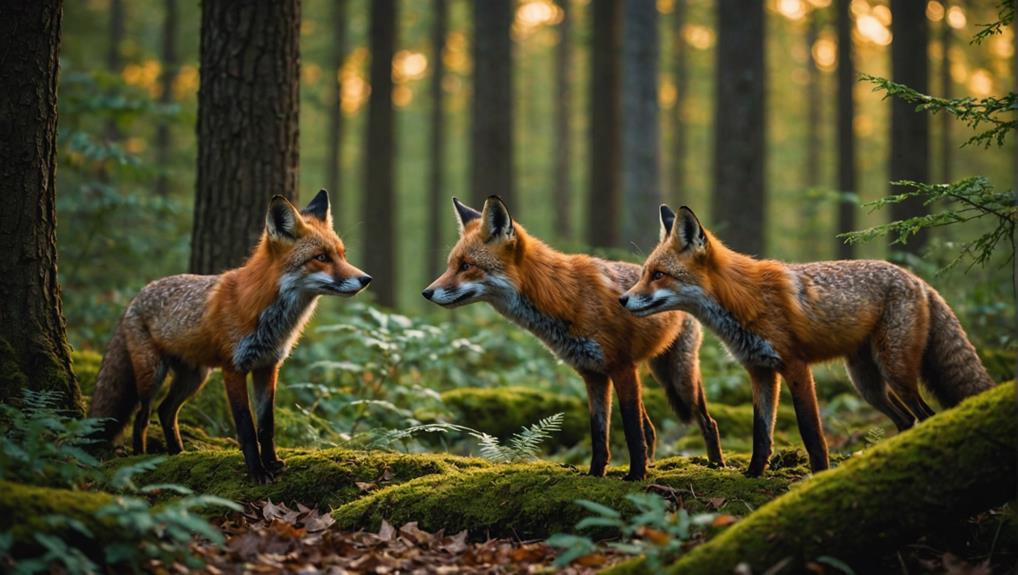
During the breeding season, vixens typically become receptive for about three weeks, creating a competitive environment where males actively vie for attention. It's quite the spectacle!
As a male fox, you might find yourself marking territory more often, signaling your presence and intentions. This dynamic is particularly interesting as urban foxes have adapted their mating behaviors to thrive in human-dominated landscapes, showcasing their remarkable flexibility in various habitats, including gardens and parks urban fox adaptability.
The courtship dance is fascinating, filled with playful interactions and attempts at bonding.
Here are three key dynamics to contemplate:
- Mating Attempts: Males often try to mate for one to six days, and rejection is common. It's like the ultimate game of hard to get!
- Guarding Behavior: Males guard vixens during oestrus. This not only reinforces pair bonding but also increases your chances of successful mating.
- Territorial Marking: Both males and females increase their urination marking as mating time approaches. This behavior shows who's in the game and ready for competition.
These courtship dynamics emphasize the interplay of male and female roles in securing a mate.
Influence of Resource Availability
When it comes to foxes, the availability of food plays a huge role in how they choose their mates.
If there's plenty to munch on, you might find these clever critters getting a bit more adventurous with their love lives, leading to some polygamous pairings.
But when food gets scarce, their romantic choices tighten up, making them stick to more monogamous relationships, kind of like dating apps during a food shortage!
Resource Scarcity Effects
Resource availability plays an essential role in shaping fox mating behaviors, with studies showing that around 50% of breeding attempts are monogamous in food-scarce environments.
When food resources dwindle, foxes adapt by forming strong pair bonds, ensuring their young have the best chance of survival. This shift to monogamous breeding is a clever strategy, especially when competition for food is fierce.
Here are three key effects of resource scarcity on fox mating behavior:
- Monogamous Breeding: In tight times, foxes often stick to one partner, which helps them focus on nurturing their offspring.
- Genetic Diversity: While monogamous breeding is common, some dominant females still seek mates outside their groups to keep the gene pool healthy.
- Breeding Patterns: Environmental factors, like changing seasons or habitat availability, can influence when and how often foxes breed.
Abundant Food Opportunities
Abundant food opportunities create a dynamic landscape for fox mating behavior. When red foxes find themselves in lush environments filled with food, it triggers some fascinating changes in how they interact.
In these resource-rich areas, you'll notice males often compete for access to multiple females. This competition can lead to polygyny, where one male mates with several females, resulting in lively family dynamics!
You might be surprised to learn that extra-pair matings become more common when food is plentiful. This means that a female might mate with a male outside her primary partnership, boosting genetic diversity in their litters. Higher litter sizes and healthier cubs often follow, thanks to the increased breeding success during these rich times.
However, it's not all sunshine and rainbows. Males may focus so much on mating that they neglect foraging, which can affect their health.
Effects of Seasonal Changes
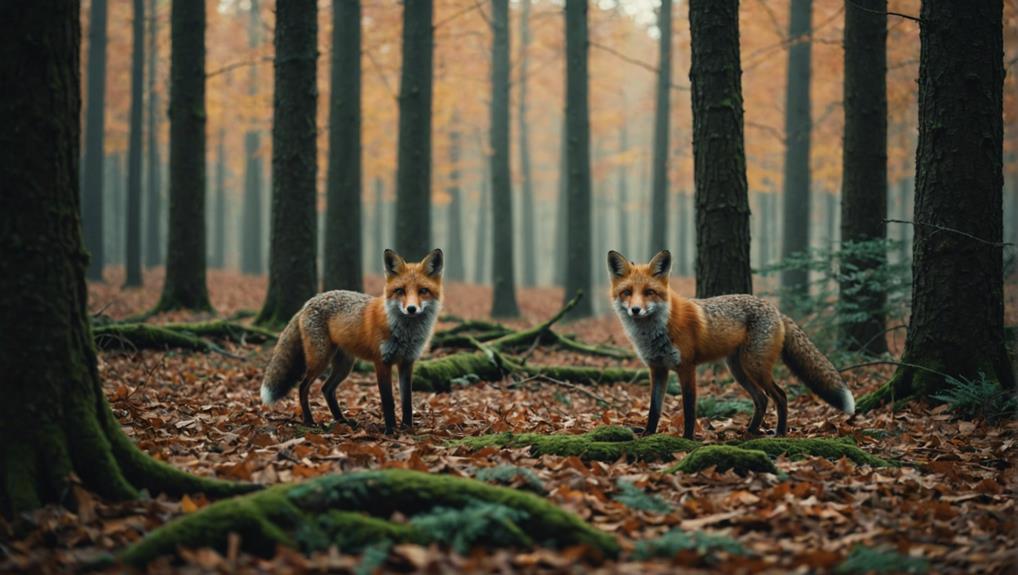
Seasonal changes play an essential role in shaping the mating behavior of red foxes. During the mating season, which typically occurs from January to March, food resources are more available, allowing foxes to focus on breeding rather than just survival.
You'll notice an increase in vocalizations and territorial marking as they assert their presence in the late winter and early spring months.
Here are three key effects of seasonal changes on red fox mating behavior:
- Resource Availability: When food is abundant, female foxes may mate outside their social groups to enhance genetic diversity, improving the health of their offspring.
- Breeding Patterns: Environmental stressors, like food scarcity, often shift foxes towards more monogamous breeding patterns, ensuring better care for their young.
- Seasonal Variations: Fluctuations in habitat quality and prey availability can lead to changes in male competition, affecting who gets to mate and when.
Understanding these dynamics helps us appreciate how red foxes adapt their behavior to their environment.
Territoriality During Mating
As the mating season approaches, male red foxes ramp up their territorial behavior to secure a breeding spot. You might be surprised to learn that these clever critters scent mark and vocalize to establish their territories.
Their territorial ranges typically span 2-8 square miles, but resource availability plays a big role in how far they roam. In areas where food is scarce, you'll see male red foxes becoming more aggressive in defending their turf.
They use physical markers and assertive behavior to signal their dominance, hoping to avoid conflicts with other males. It's like a game of "who can shout the loudest" to impress the ladies!
Curiously, when resources are plentiful, non-territorial males may sneak into established territories for a chance at extra-pair mating. However, this can lead to some intense, aggressive interactions between competing males.
Territoriality isn't just a strategy; it's crucial for reproductive success during the mating season. So, the next time you hear a fox howling, remember, it's not just a song—it's a declaration of their claim to love and resources!
Genetic Diversity in Breeding
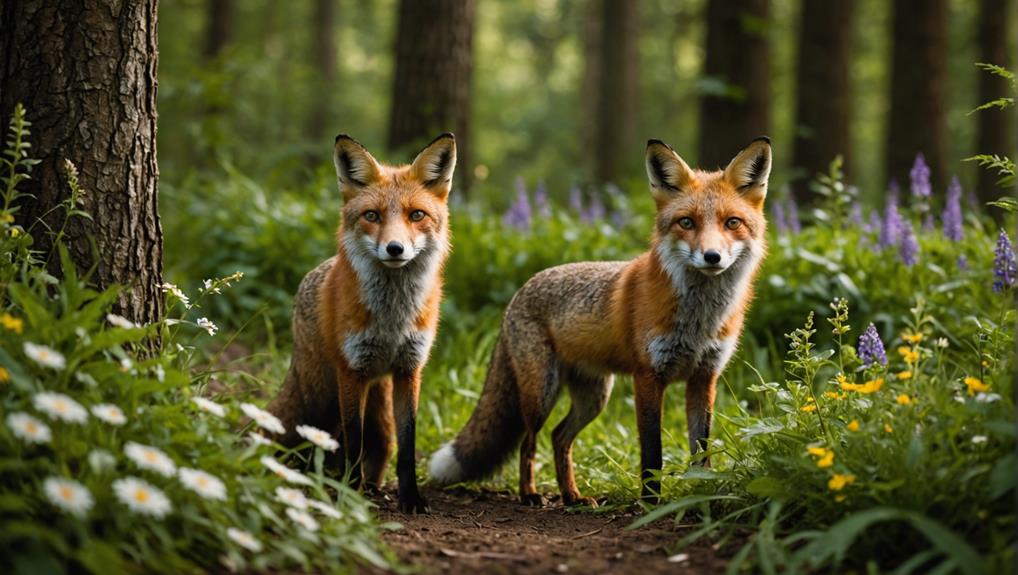
Genetic diversity in red fox breeding often surprises researchers, revealing a more complex mating system than previously thought. Contrary to the image of foxes as strictly monogamous, genetic data show that about one-third of litters may have multiple fathers. This challenges the traditional views of mating.
Here are three key points to evaluate:
- Monogamy vs. Polyandry: While monogamy is seen in about 50% of breeding attempts, some females engage in polyandry or even polygyny, depending on food availability and other environmental factors.
- Dominant Females: These females often step outside their social group to mate, enhancing genetic diversity. Meanwhile, subordinate males may struggle with lower reproductive success.
- Resource Impact: In food-scarce environments, monogamous pairings thrive, but when resources are plentiful, you'll witness more diverse mating strategies.
The way foxes adapt their reproductive strategies based on their surroundings highlights the importance of genetic diversity.
After all, it's not just about who gets to mate; it's about ensuring the survival of their adorable little cubs! Isn't nature fascinating?
Impact of Population Density
Population density plays a significant role in shaping the mating behavior of red foxes. When more foxes crowd an area, competition for resources heats up. This often leads to a shift from monogamous pair bonding to extra-pair copulations, as foxes seek other partners to guarantee their genes are passed on.
In places where food is abundant, red foxes might even embrace a polygynous system, celebrating multiple mates like a buffet of love! But in leaner environments, they tend to stick to monogamy, focusing on raising their young successfully.
Interestingly, male foxes in high-density areas become more territorial, expanding their ranges in search of mates. This behavior shows how population density directly affects their mating strategies. You might notice that during the breeding season, increased male-male competition can lead to some quite dramatic courtship displays. It's like a reality show featuring the ultimate fox dating game!
Genetic studies reveal that around one-third of urban fox litters have multiple fathers, thanks to those extra-pair copulations. This strategy enhances genetic diversity, proving that even in the wild, love can be complicated!
Conservation Implications
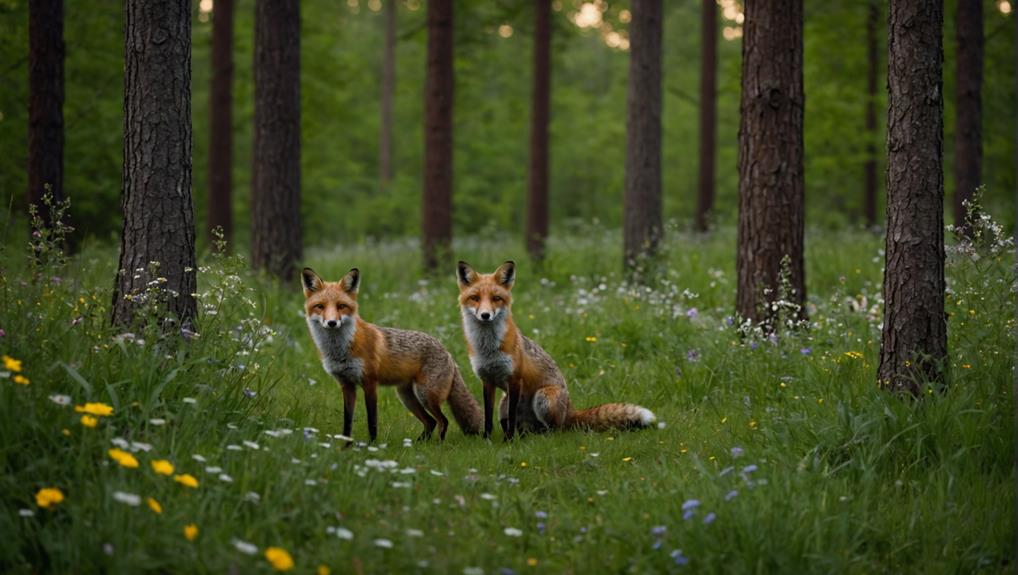
Understanding the mating behaviors and social structures of foxes is vital for effective conservation strategies. When you understand how these clever creatures interact and reproduce, you can make better decisions for their protection.
Here are three key points to contemplate:
- Habitat Availability: Protecting habitats is essential. If urban foxes lose their homes, their mating behaviors and reproductive strategies can suffer. This can lead to fewer cubs and reduced genetic diversity.
- Urban Management: We need to learn how city life affects foxes. By understanding their social interactions and breeding habits, we can reduce conflicts between humans and wildlife. After all, no one wants a surprise encounter with a fox rummaging through trash!
- Future Research: Ongoing studies about climate change and resource availability can help us create better conservation strategies. The more we understand about these factors, the more we can guarantee the fox population thrives.
Frequently Asked Questions
What Is the Mating Behavior of Foxes?
Foxes engage in elaborate courtship rituals, using vocal communication and territory marking to attract mates. During breeding seasons, they prioritize mate selection, enhancing reproductive success through strategic behaviors and forming strong bonds with their partners.
How Do Foxes Interact With Their Environment?
So, you think foxes are just furry little socialites? They actually master habitat selection, strategize food availability, practice predator avoidance, mark territory, engage in social interactions, and construct dens to thrive in their wild world!
How Are Foxes Affected by Climate Change?
Climate change affects fox reproduction patterns by altering temperature effects, habitat loss, and prey availability. As seasonal variations shift, you'll notice changes in social dynamics, impacting how foxes adapt and thrive in their environments.
What Behavioural Adaptations Do Foxes Have?
Foxes adapt through social bonding, enhancing hunting strategies and vocal communication. They mark territory, display seasonal adaptations, and provide parental care, balancing competition with cooperation to thrive in their ever-changing environment and support their community.
Final Thoughts
In the grand dance of life, foxes have their own rhythm shaped by the world around them. From seasonal shifts to the availability of food, every little detail influences how they find their mates. Understanding these factors not only helps us appreciate their unique courtship but also reminds us of the delicate balance in nature. So, the next time you spot a fox, think about the wild love story unfolding under the trees, influenced by everything around them!

